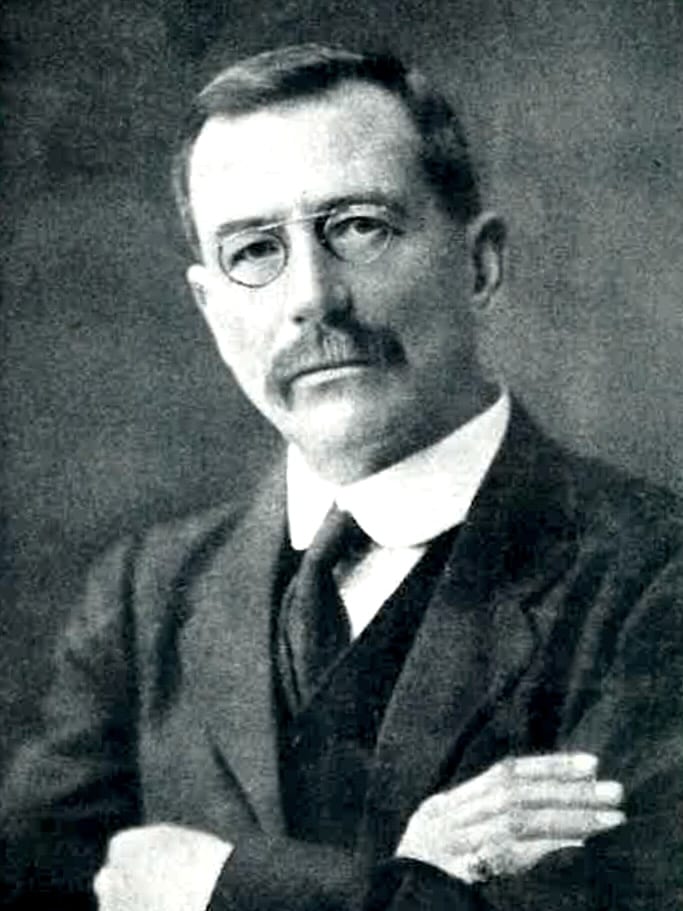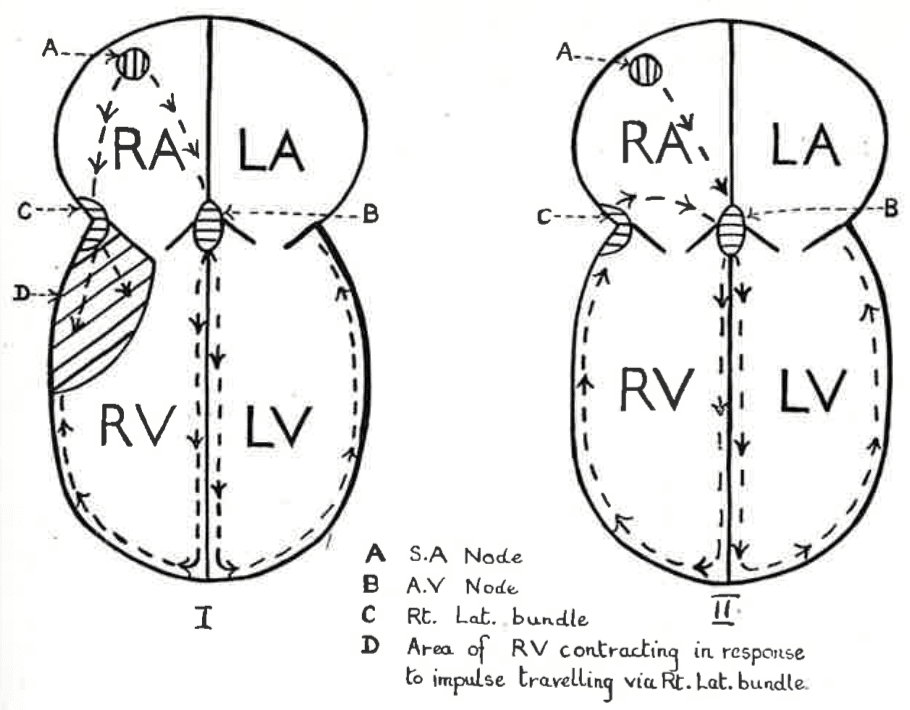AF Stanley Kent

Albert Frank Stanley Kent (1863-1958) was an English physiologist
A. F. Stanley Kent was an English physiologist and histologist whose eponymous legacy, the bundle of Kent, remains foundational in the understanding of cardiac electrophysiology. In 1892, Kent demonstrated muscular atrioventricular connections in mammalian hearts, preceding the description by Wilhelm His Jr. (1863–1934) and anticipating the modern conception of accessory pathways as seen in Wolff–Parkinson–White (WPW) syndrome. His detailed histological work, presented to the Physiological Society and published in 1893, was grounded in careful anatomical and experimental evidence, and is now recognised as a landmark in cardiac conduction research.
Kent’s career extended well beyond the heart. As the first full-time Professor of Physiology at University College, Bristol (later the University of Bristol), he transformed a poorly resourced department into a thriving academic unit with state-of-the-art equipment including Bristol’s first electrocardiograph and a dedicated research laboratory. He was instrumental in founding a clinical bacteriology service and was a central figure in the long campaign to establish a full university in the West of England. His initiative led to the creation of an Economic Biology group, which evolved into the Agricultural Research Station at Long Ashton.
In 1918, Kent left Bristol to pioneer the emerging discipline of industrial physiology. He directed the Department of Industrial Administration at Manchester Municipal Technical College, advised the Ministry of Munitions on factory fatigue, and contributed to government policy on worker welfare, nutrition, and safety. He continued experimental research into his retirement, working from a converted home laboratory in Iron Acton, and maintained correspondence and collegial ties with figures such as Sir Charles Sherrington (1857-1952).
Remembered by students as a brilliant teacher and by colleagues as a modest innovator, Kent was described in 1953 as “the man who found the Physiology Department at a low ebb of efficiency and left it in a condition to become a first-class going concern.” Warm, humorous, and deeply principled, he exemplified the uncommon man whose scientific foresight and humanistic values shaped both discipline and institution.
Biographical Timeline
- 1863 – Born March 26 in Stratford Tony, Wiltshire, England, son of Rev. George Davies Kent and Anne Rudgard.
- 1886 – Graduated B.A. (Natural Sciences, Physiology) from Magdalen College, Oxford.
- 1887 – Elected member of the Physiological Society.
- 1887–1889 – Demonstrator in Physiology, Owen’s College and Victoria University, Manchester.
- 1889–1891 – Demonstrator in Physiology, University of Oxford.
- 1891–1895 – Lecturer in Physiology, St Thomas’s Hospital, London; helped develop the hospital’s early X-ray department.
- 1892 – Presented histological findings on atrioventricular conduction pathways to the Physiological Society.
- 1893 – Published foundational work describing muscular connections between atria and ventricles (bundle of Kent); predating His in anatomical discovery.
- 1899 – Appointed first full-time Professor of Physiology at University College, Bristol.
- 1900 – Proposed and co-founded the committee advocating for the establishment of the University of Bristol.
- 1900–1902 – Founded and personally funded a Clinical and Bacteriological Research Laboratory in Bristol, handling hundreds of public health specimens.
- 1903 – Advocated for industrial physiology at the International Congress of Hygiene and Demography in Brussels.
- c.1905–1915 – Helped establish the Department of Economic Biology, precursor to the Agricultural Research Station at Long Ashton.
- 1913–1915 – Conducted further experiments on the cardiac conducting system, particularly the right lateral bundle.
- 1914–1916 – Served with the University OTC; conducted industrial fatigue studies; presented findings to Parliament in 1915. Work on industrial fatigue received heightened national attention during wartime munitions production; visited factories across Britain.
- 1918 – Resigned from Bristol; appointed Director of the Department of Industrial Administration, Manchester Municipal Technical College.
- 1919 – Introduced Jules Amar’s Physiology of Industrial Organisation; delivered Rowntree Lecture on industrial fatigue.
- 1920–1922 – Editor in Great Britain for the Journal of Industrial Hygiene; established prominence in the nascent field of industrial medicine.
- 1920s–1940s – Continued research in retirement; maintained a home laboratory in Iron Acton, Gloucestershire.
- 1939–1945 – Served in the Home Guard during WWII as musketry instructor and quartermaster.
- 1953 – Celebrated 90th birthday; honoured in a special edition of The Black Bag (Bristol University Medical Journal):
- Recollections from students and colleagues highlighted his humour, scientific rigour, teaching innovations, and foresight in electrocardiography.
- Credited for acquiring Bristol’s first Einthoven string galvanometer and for founding the Physiology Department as a credible academic unit.
- 1958 – Died March 30 at St Martin’s Hospital, Bath, aged 95.
Medical Eponyms
Bundle of Kent (1893, 1913)
An accessory pathway consisting of conductive tissue that dissects the atrioventricular fibrous skeleton providing a direct connection between the atria and the ventricles bypassing the AV node.
1892–1893 – On November 12, 1892 Kent presented to the Physiological Society at St Mary’s’s Hospital, London his discovery of muscular connections bridging the atria and ventricles in mammalian hearts. He identified three distinct muscular bridges: (1) right lateral, (2) left lateral, and (3) septal and later published his Researches on the Structure and Function of the Mammalian Heart in the Journal of Physiology (1893). This preceded the work of Wilhelm His Jr. (1863–1934) who described the atrioventricular bundle (bundle of His), believing this to be the only communication between atria and ventricles.
1913–1915 – Kent expanded on his earlier work with microphotographs and animal experiments. He identified a “right lateral bundle” with muscle fibres and neural elements, capable of sustaining AV conduction even after other pathways were surgically severed. He proposed that the structure could delay conduction, anticipating modern understanding of AV nodal function.
1913 – Kent described, in the human heart, a communication between the right atrium and ventricle, in the lateral aspect.
The muscular connection between auricle (atrium) and ventricle in the heart of man is not single and confined to the A.V. bundle, but it is multiple. One point at which a muscular connection between auricle and ventricle exists is situated at the right margin of the heart. The coordinated action of the chambers of the heart is to some extent dependent upon the integrity of muscular connections other than that which exists in the A.V. bundle. It is proposed, for purposes of identification, to refer to the connection described as the “right lateral auriculo-ventricular” connection.
Kent AFS 1913
1914 – In this region, he described a right lateral atrioventricular node of specialized tissue which communicated with both atrium and ventricle.
…the only tissue connecting the auricle to the ventricle is the strip at the right side of the heart, and the histological part of the inquiry has already shown that an anatomical connexion exists in this situation, it is impossible to avoid the conclusion that in this right lateral auriculo-ventricular junction there exists a muscular path capable of transmitting impulses and of co-ordinating the action of the chambers of the heart.
AFS Kent, BMJ 1914

Although it is widely accepted that the atrioventricular bundle was discovered by Wilhelm His Jr in 1893 (Bundle of His) many argue it was first described by Kent at the Physiological Society meeting in November 1892.
Posthumous influence – Kent’s findings were largely overlooked during his lifetime but resurfaced as foundational in the understanding of Wolff–Parkinson–White (WPW) syndrome. In the 1930s–40s, researchers such as Charles C. Wolferth (1887-1965) and Francis Clark Wood (1901-1990) proposed that accessory AV pathways such as the right lateral bundle Kent described underlay the WPW ECG pattern and its paroxysmal tachyarrhythmias. Wolferth and Wood proposed the eponymous term the “bundle of Kent”, and though disputed by some, the term endures as a clinical descriptor for accessory pathway from the atria to the ventricles, bypassing the AV node.

Diagrams showing the possible mechanism of the Wolff-Parkinson-White syndrome if due to a “right lateral bundle.of Kent”
I. The path of the impulse in the Wolff-Parkinson-White syndrome.
Il. The mechanism of the paroxysmal tachycardia : An impulse reaching the ventricle by the A-V node re-enters the atrium via the “right lateral bundle of Kent” (Wolferth and Wood, 1933.)
Key Medical Contributions
Bacteriology, Hygiene, and Public Health Innovation
In Bristol, Kent founded and operated a Clinical and Bacteriological Research Laboratory from 1900–1903 at his own expense. The lab supported local medical officers with diagnoses of tuberculosis, typhoid, and diphtheria, examined hundreds of public health specimens, and offered training to future physicians. He later handed the successful lab over to the College, cementing bacteriology as a clinical pillar.
Kent also established early research on food hygiene, soil contamination, and agricultural pests, and helped create a multidisciplinary Department of Economic Biology, a forerunner to Long Ashton Agricultural Research Station. These initiatives reflected his vision of applied science serving community health.
Industrial Physiology and the Science of Fatigue
Kent was a pioneer of industrial physiology, applying scientific principles to worker health and productivity long before the formal rise of occupational medicine. During WWI, he investigated fatigue in munitions workers and advised the Ministry of Munitions on improving factory conditions. His research addressed not only physical strain, but also emotional stress, lighting, nutrition, and social relations.
In lectures, reports to Parliament, and government commissions (1915–1919), Kent emphasized the physiological and psychological toll of poorly managed work environments. He described “the Monday effect” (a decline in output due to weekend overindulgence), and stressed the impact of worry, grief, glare, and indigestion on efficiency:
Unfriendly supervisors have been quoted as a cause of serious loss of output. Dazzling lights, improperly arranged, by straining and irritating the workers’ eyes, may lead to a mental condition incompatible with good digestion.
AFS Kent in ‘Industrial Fatigue’, 1919
Kent’s model anticipated later developments in ergonomics, mental health at work, and occupational safety. His fieldwork spanned engineering workshops, surgical dressings factories, and coal mines, and included experimental data on reaction time, blood pressure, and visual strain.
Controversies
Digitalis and the Heart Block Debate
Kent’s anatomical work on the AV junction also shaped therapeutic theory. In the early 20th century, Sir James Mackenzie cited Kent’s bundle as the anatomical site where digitalis exerted its slowing effect in atrial fibrillation, a view widely accepted in British medicine at the time.
Later pharmacological reviews (see Ginsburg, Black Bag, 1953) clarified that digitalis also acted on vagal tone and myocardial contractility, but Kent’s model helped unify clinical and anatomical perspectives on conduction delay and ventricular rate control. This link between physiology and pharmacotherapy was vital in building the rationale for AV nodal targeting in arrhythmia management.
At the beginning of the twentieth century, Mackenzie found that one of the effects of digitalis was to depress conduction in the bundle of Kent and that in cases of auricular fibrillation this reduced the stream of impulses passing from auricle to ventricle. The ventricle is thus permitted to beat more slowly and more effectively, resulting in an improved circulation.
Ginsburg 1953
Major Publications
- Kent AFS. Researches on the Structure and Function of the Mammalian Heart. Proceedings of the Physiological Society, 1892. No. VI. J Physiol. 1893 Jan;14(1):xxiii-xxiv.
- Kent AFS. Researches on the Structure and Function of the Mammalian Heart. Journal of Physiology. 1893; 14: 233-254.
- Kent AFS. Observations on the auriculo-ventricular junction of the mammalian heart. Quarterly Journal of Experimental Physiology. 1913; 7: 193–195.
- Kent AFS. The structure of the cardiac tissues at the auriculo-ventricular junction. Journal of Physiology 1913; 47(supp): 17- 18
- Kent AFS. The right lateral auriculo-ventricular junction of the heart. In: Proceedings of the physiological society on March 14, 1914. Journal of Physiology 1914; 48(supp): 22-24.
- Kent AFS. A conducting path between the right auricle and the external wall of the right ventricle in the heart of the mammal. In: Proceedings of the physiological society on June 27, 1914. Journal of Physiology 1914; 48(supp): 57
- Kent AFS. Illustrations of the right lateral auriculo-ventricular junction in the heart. Journal of Physiology 1914; 48(supp): 63–4.
- Kent AF. A Lecture on some problems in cardiac physiology: Delivered before the University of London, June 18th, 1914. Br Med J. 1914; 2(2794): 105-106
- Kent AFS. Second interim report on an investigation of industrial fatigue by physiological methods. 1916
- Kent AFS. Fatigue and Alcohol. British Journal of Inebriety. 1917: 15(2): 49-68
- Amar J, Kent AFS. The physiology of industrial organisation and the re-employment of the disabled. 1918
References
Biography
- O’Connor WJ. Albert Frank Stanley Kent (1863 – 1958) In: British physiologists 1885-1914: a biographical dictionary. Manchester Univ 1991: 330-331
- Brocklehurst RJ. Kent, Albert Frank Stanley Oxford Dictionary of National Biography
- Bibliography. Kent, A. F. Stanley (Albert Frank Stanley) 1863-1958. WorldCat Identities
- The Black Bag. Professor AFS Kent. Journal of the Medical Faculty of Bristol University. Vol IX(2). Spring Term 1953
- Photograph of Rowing Four, Winners, 1882. Magdalen College School Archive Catalogue
Eponymous term
- Wolferth CC, Wood FC. The mechanism of production of short P-R intervals and prolonged QRS complexes in patients with presumably undamaged hearts: Hypothesis of an accessory pathway of auriculoventricular conduction (bundle of Kent). American Heart Journal 1933; 8(3): 297-311
- Lev M, Lerner R. The theory of Kent; a histologic study of the normal atrioventricular communications of the human heart. Circulation. 1955;12(2):176-184.
- Anderson RH, Becker AE. Stanley Kent and accessory atrioventricular connections. J Thorac Cardiovasc Surg. 1981; 81: 649–658.
- Boukens BJ and Janse MJ. Brief history of arrhythmia in the WPW syndrome – the contribution of George Ralph Mines. J Physiol. 2013; 591: 4067–407.
- Anderson RH. Arthur Stanley Kent and accessory muscular atrioventricular connections. Cardiovascular Pathology, 2019; 40: 1
Eponym
the person behind the name
Will Palmer, fourth Year Medical Student at the University of Bristol. Editor Black Bag magazine (2025); Events Director for Bristol University Emergency Medicine Society; National Child Protection Director for the charity Sexpression:UK
BA MA (Oxon) MBChB (Edin) FACEM FFSEM. Emergency physician, Sir Charles Gairdner Hospital. Passion for rugby; medical history; medical education; and asynchronous learning #FOAMed evangelist. Co-founder and CTO of Life in the Fast lane | On Call: Principles and Protocol 4e| Eponyms | Books |

